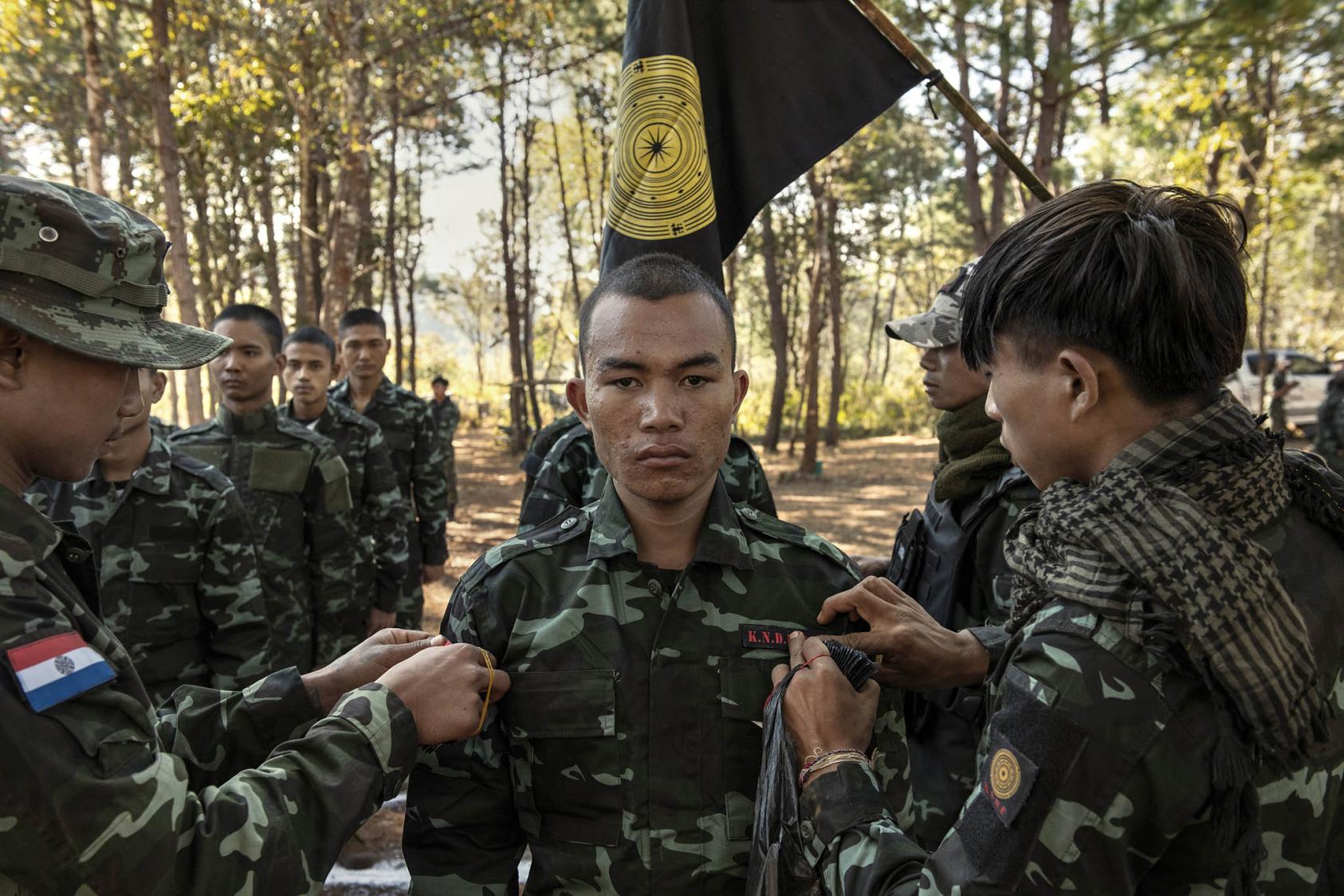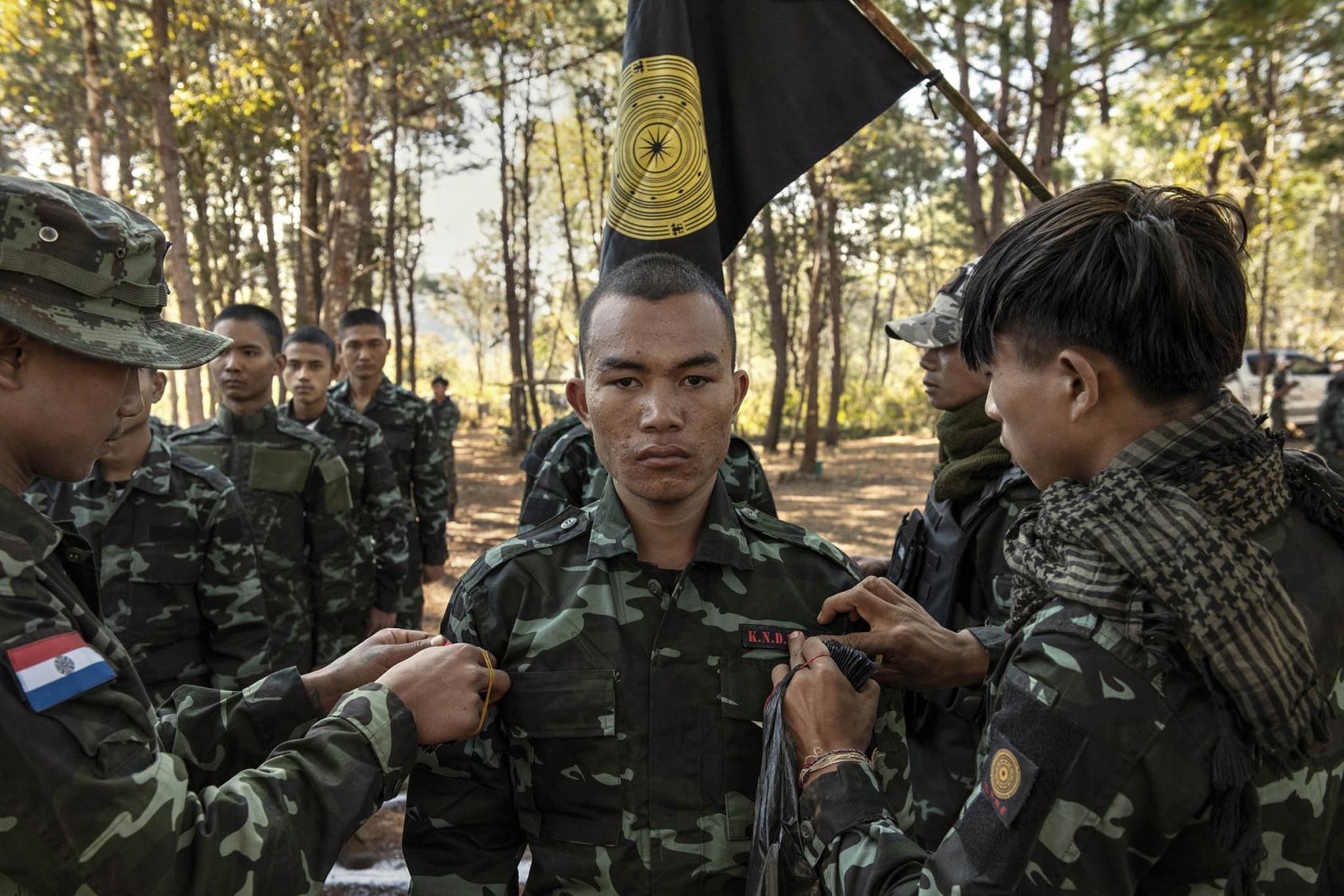As the country heads into a decisive year, Myanmar’s military is losing ground to resistance forces.
On March 28, 2021, barely two months after the February 1 coup in Myanmar, a minor skirmish erupted at the Tarhan protest in Kalay township in central Sagaing region as demonstrators took up makeshift weapons to defend themselves against ruthless assaults by the junta’s security forces. This was the first recorded instance of civilian armed resistance to the military’s violent crackdown on peaceful protesters since the February 1 coup d’état.

More than three years later, the landscape of the country’s conflict has undergone a profound transformation. The military faces a national uprising that spans the breadth of the country. Unprecedented in its history, Myanmar’s military has lost control over vast swathes of territory and strategically significant bases. Facing an increasingly coordinated and well-equipped resistance that enjoys widespread public support, there appears to be no way back for the regime.
According to ACLED, which monitors armed conflict around the world, the warfare in Myanmar currently ranks as the most intense violent conflict among the 50 countries it monitors. However, it has garnered little international attention. Its complexity has led many to revert to fatalistic narratives that Myanmar is irreconcilably fractious and that the military is bound to dominate. These narratives have led policymakers in some countries to conclude they have no choice but to engage the junta. The past three years have clearly shown these narratives to be false.
Nine Guideposts for Policymakers
Having closely observed and analyzed the resistance movement and armed conflict over the past three years, I have arrived at nine key observations that can guide policy discussions.
- Although the resistance has far outperformed international expectations, many within the movement saw this coming. Since the inception of armed resistance, several international analysts predicted that the public would be easily ground into submission and resistance troops would exhaust themselves in their struggle against the powerful military. Instead, people have proven resilient, supported one another despite the junta’s efforts to create suffering and displacement, and the armed resistance has grown in strength. Despite international pessimism, many within the movement who understand the public’s motivation and unwillingness to be pacified by the military said from the beginning that they would prevail. These voices should be taken more seriously.
- Trends matter more than incidents. As per my data, conflict incidents since the start of the armed resistance have occurred in 233 of 330 townships, with 45 towns now under the control of various resistance groups. In the country’s protracted history of civil war, the magnitude of the current conflict and the territorial gains made by the resistance forces are unprecedented. The ongoing setbacks to the military are part of the pattern of the three-year trend of conflicts. These trends should be the primary focus of analysis — not isolated incidents that most analysts struggle to contextualize. Major events such as Operation 1027 garner the attention of analysts and policymakers as “inflection points” or a “shift”; however, they are emblematic of durable long-term and nationwide trends.
The gains from Operation 1027 — an offensive launched in October 2023 by an alliance of three ethnic armed organizations (EAOs) against the military junta — are the result of long-term trends of growing resistance coordination on the ground, a withering junta capacity and sustained public support for the movement. While history plays a role in interpreting conflicts like Myanmar’s, many overemphasize its importance, leading to faulty comparisons. The argument that the Myanmar military has succeeded against multifront resistance in the past and, therefore, can again, often misrepresents history and offers limited predictive value. Worse, these arguments have fueled erroneous policymaking based on the belief that the military is stronger and more resilient than it actually is. - The Myanmar military is significantly weaker than previously believed and troop numbers are important. Within three years of the conflict, the military has suffered significant losses of ground troops due to defections, casualties and surrenders. As a result, the total number of combat and noncombat troops has now dwindled to 130,000, according to my estimates, with auxiliary forces of police and militias comprising around 70,000 — compared to earlier estimates of at least 300,000. Despite desperate attempts to replenish these losses — most recently through forced conscription — the shortage of manpower has made it challenging to hold territory and nearly impossible to retake lost territory.
Conversely, the current estimate of the resistance forces, newly founded after the coup, such as People’s Defense Forces (PDFs), Local Defense Forces and People’s Defense Team, stands at approximately 85,000 troops, according to my estimates. EAOs, many of which have fought the military for decades, have grown in strength since the coup to about 120,000 troops. Although the military has a significant advantage in air power and heavy weaponry, recent developments have proven the resistance’s superior morale, improved weaponry and the public’s support have enabled it to achieve major and unexpected gains. - The Myanmar military is not capable of retaking the territory it has lost in ethnic minority areas.
EAOs have emerged as key players in the post-coup conflict landscape. Many have dismantled the military’s control apparatus in their territory or pushed them out entirely. As military power shifted to EAOs, so has political power. The military has lost over 60% of territory it controlled in ethnic minority areas — most significantly in the past six months alone. Facing heavy military pressure in many regions simultaneously and depleted troop levels, the military is seldom able to recapture lost bases and territory in these ethnic areas. For example, the regime has expended enormous resources to avoid losing Myawaddy, a crucial trade post on the Thai border, by making concessions to the Border Guard Force (BGF). However, sustaining control in this area, where it is surrounded by resistance forces, is unrealistic in the long run. With control slipping in ethnic areas, the military is focusing on preventing further losses in ethnic minority areas and has prioritized restoring control in the heartland of Myanmar, where newer PDFs are relatively weak. This is evident in successful counteroffensives to regain control of Kani and Kawlin. However, in the long run, it will likely struggle to maintain control even in these areas within Myanmar’s heartland given that it has virtually no public support. - The military’s apparatus of population and territory control is withering. The junta faces a public that is intent on its demise and unwilling to be pacified. As its apparatus of control disintegrates, so does any prospect that it can consolidate power. Of its 5,280 military positions, including outposts, bases and headquarters, the military has lost control of approximately 2,500, according to my data. Most of these bases were overrun by the resistance. In some cases, the Sit-Tat, as the military is known, withdrew strategically, but the vast caches of abandoned junta weapons demonstrate that “strategic consolidation” is the exception. The military also asserts control through its 330 General Administration Department offices and its BGF. The military has lost many General Administration Department offices with others actively collaborating with the resistance. Its BGF structure is collapsing as one of its BGFs defected, another is defunct and it has lost control of others.
This infrastructure has been instrumental in sustaining military dictatorships in Myanmar for decades and has been utilized repeatedly to initiate coups. This vast apparatus of control has enabled the military chief to stage coups against the public will by activating this apparatus of territorial and population control. Having lost much of its apparatus of control, another coup would be much less likely in the event that a civilian government emerges in place of this junta. - The Myanmar military remains the primary agent of instability. Before the coup, the Myanmar military’s atrocities against ethnic minorities and genocide of Rohingya Muslims created millions of refugees, burdening Myanmar’s neighbors. Since the coup, millions more have been displaced because of the junta’s campaign against the public. Recent airstrikes by the military in Myawaddy have forced residents to flee to Thailand, highlighting the regime’s ongoing destabilizing activities. Forced conscription has driven thousands of young people to seek refuge in liberated areas or outside Myanmar, leading to a surge in transnational criminal activities in the region. It represents the latest in a series of destabilizing actions by the military, which have plunged the country into turmoil with the military’s sustained record of economic and financial mismanagement, as well as its campaigns against the people. Many have long understood the Myanmar military as the primary agent of instability, but for the first time in decades there is an opportunity to build a new, more stable governance structure.
- Resistance coordination will be a decisive factor in shaping the outcome of the current conflict. After three years, the myriad resistance forces still struggle to coordinate strategically in their fight against the military. Since the onset of the resistance, many actors, particularly the National Unity Government (NUG) and EAOs, have endeavored to establish joint command. Tactical coordination has improved markedly but strategic coordination that is needed for synchronized nationwide offensives remains elusive. Facilitating strategic coordination among the plethora of groups will take time, but it will be a decisive factor in determining the outcome of the conflict in Myanmar.
- War in Myanmar will not stop until the military is removed from a position of political power. Conflict will continue to escalate this year — particularly if international actors, who overestimate the junta’s capability or demand it remains in a position of political influence, continue to prop up the enfeebled junta. The public remains resolute in their fight against the regime. They will not stop until the military does not have political power. Likewise, EAOs view the current situation as an opportunity to oust the military and consolidate control in their respective areas. As long as the regime remains in power, resistance forces nationwide will persist in their efforts to combat the illegitimate and oppressive regime.
- This year may prove to be a decisive one for the conflict in Myanmar. Over the past six months, in northern Shan, Kachin, Karenni, Karen, Rakhine and Chin states, powerful EAOs have been escalating their attacks, gradually seizing control of additional towns and military positions. Concurrently, PDFs have been intensively preparing to infiltrate major cities and capitals. Recent attacks in Naypyitaw and Pyin Oo Lwin suggest that PDFs are prepared to launch operations in key urban areas, the regime’s major strongholds, bolstered by increasing weaponry and combat capabilities. The generals in Naypyitaw have few options but to persist in their ruthless campaign and plead for help from their international enablers. This year could be a decisive one, shaping the conflict’s trajectory for years to come.
Armed Resistance at a Crossroads
Myanmar’s resistance movement finds itself at a pivotal crossroads that could shape the destiny of the nation for years to come. The resistance movement has sustained itself and matured over three years of opposition to the junta regime. Over the past six months, a profound transformation has occurred, tilting the balance of power decisively in favor of the resistance forces. What stands out amid the turmoil is the stark realization that the Myanmar military’s domination of the country is no longer a given. Instead, it is an array of resistance stakeholders who will determine the trajectory of Myanmar’s future.
